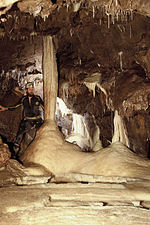Harridge Wood
Forests and woodlands of SomersetMining in SomersetNature reserves in Somerset

Harridge Wood is an area of woodland in Somerset, England. From about 1300 AD part of the wood was the scene of coal mining, which continued until around 1800. The traces of mining have been well preserved, and are now a scheduled site. The woodland is now part of the Harridge Woods Nature Reserve. Large areas were planted for timber in the mid-20th century, and this continues to be harvested. The nature reserve is steadily reintroducing the original flora.
Excerpt from the Wikipedia article Harridge Wood (License: CC BY-SA 3.0, Authors, Images).Harridge Wood
A367, Mendip
Geographical coordinates (GPS) Address Nearby Places Show on map
Geographical coordinates (GPS)
| Latitude | Longitude |
|---|---|
| N 51.231604 ° | E -2.50178 ° |
Address
Oakhill WwTW
A367
BA3 5FA Mendip
England, United Kingdom
Open on Google Maps










